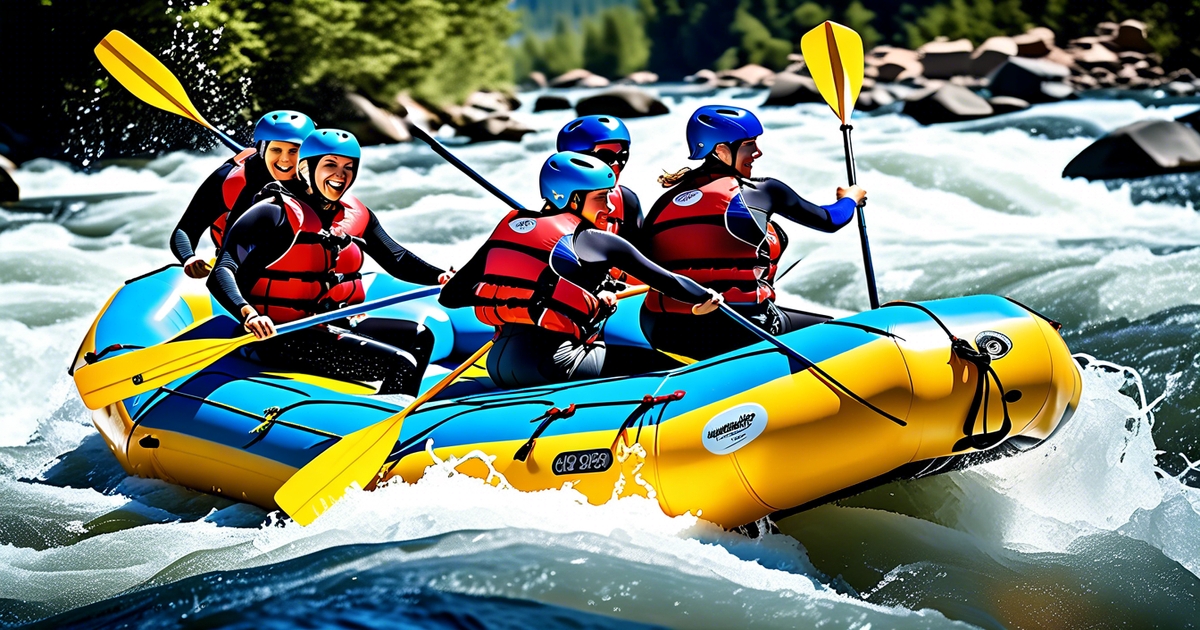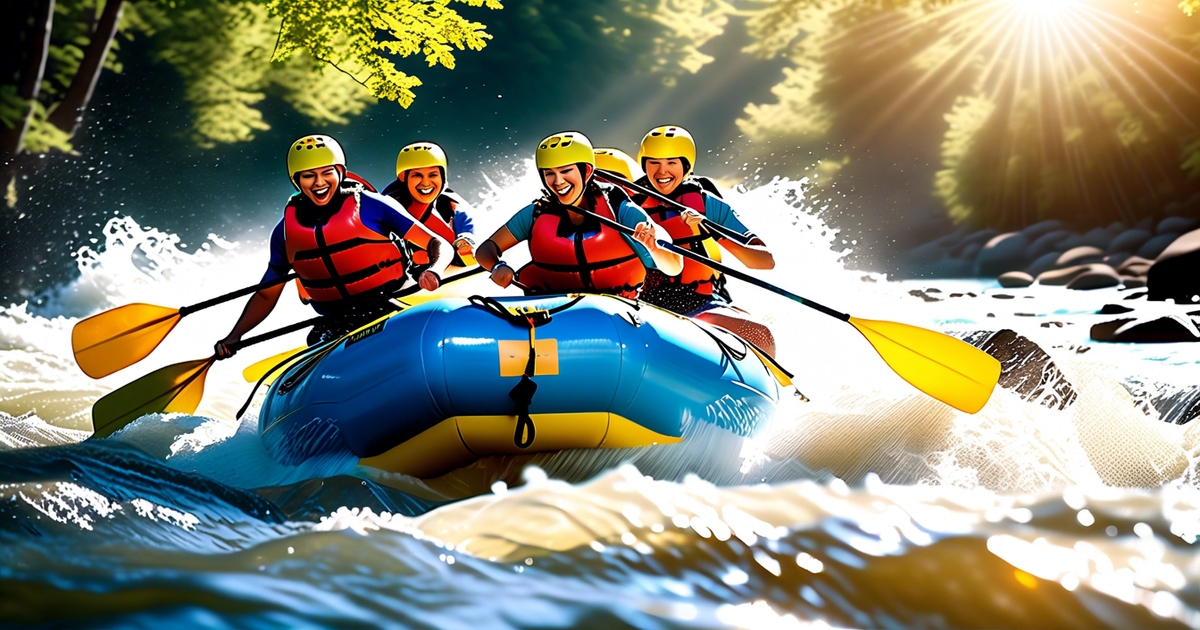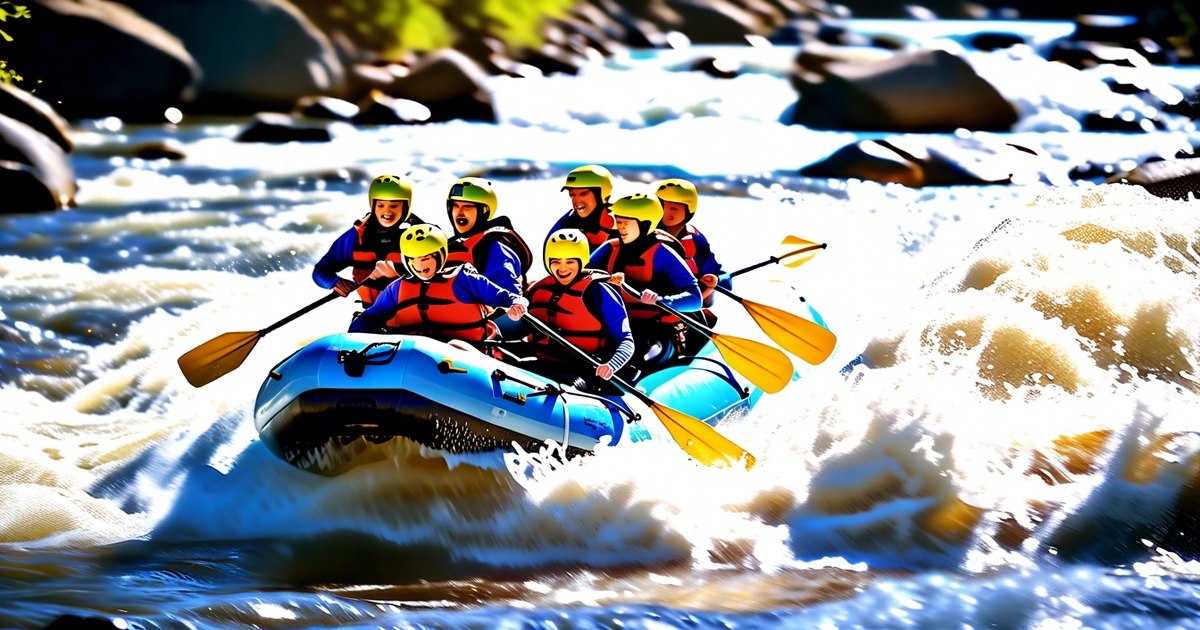Did you know that whitewater rafting originated as a mode of transportation in the mid-19th century, evolving into an exhilarating recreational activity? This thrilling water sport involves navigating turbulent river rapids aboard inflatable rafts, providing an adrenaline rush like no other exceptional rafting experience. Whitewater rafting enthusiasts seek the perfect blend of adventure, teamwork, and nature’s raw power as they conquer challenging rapids.
Key Takeaways
- Whitewater rafting involves navigating rough waters in inflatable rafts, providing an exciting and adventurous experience.
- Understanding the basics of whitewater, such as class levels, terminology, and rapid, is crucial for a safe and enjoyable rafting trip.
- Different types of rafting trips cater to varying skill levels and preferences, from leisurely scenic floats to adrenaline-pumping rapids.
- Prioritizing safety measures, like wearing proper gear and following guide instructions, is essential to mitigate risks associated with whitewater rafting.
- Adequate preparation, including familiarizing yourself with gear and techniques, can enhance your overall rafting experience and confidence on the water.
- Exploring the history and innovations in rafting equipment can deepen your appreciation for this exhilarating outdoor activity.
Defining Whitewater Rafting
Origins
Whitewater rafting, originating in the mid-19th century, evolved from river navigation into a thrilling recreational activity. It gained popularity for its adrenaline-pumping nature.
Distinction
Whitewater rafting stands out from other river activities due to its intense and unpredictable nature. Unlike traditional boating, river rafting trip involves navigating turbulent waters and challenging rapids.
Sense of Freedom
Participants in whitewater rafting often describe a profound sense of freedom and exhilaration. The rush of conquering roaring rapids instills a feeling of accomplishment and self-discovery.
Understanding Whitewater Basics
Techniques for Navigation
Whitewater rafting requires mastering essential techniques for navigating whitewater rapids. Rafters must learn to paddle efficiently, read the river’s flow, and communicate effectively with their team. Proper paddle strokes and positioning are crucial for maneuvering through turbulent waters. Understanding how to use eddies and currents to your advantage can help in avoiding obstacles and staying on course.
Classifications of Rapids
Whitewater is classified into different categories based on difficulty levels, ranging from Class I (easy) to Class VI (extremely dangerous). Each classification signifies the level of challenge and risk involved in navigating the rapids. Novice rafters typically start with Class I or II rapids, while experienced whitewater enthusiasts may seek the adrenaline rush of tackling higher classes.
- Class I: Gentle ripples, suitable for beginners.
- Class II: Straightforward rapids with clear channels.
- Class III: Moderate difficulty with irregular waves.
- Class IV: Intense, powerful rapids requiring precise maneuvers.
- Class V: Extremely challenging, with violent rapids and complex routes.
- Class VI: Unpredictable and potentially life-threatening conditions.
Importance of Teamwork
Successful whitewater rafting heavily relies on teamwork and coordination among rafters. Communication is key in swiftly responding to changing river conditions and executing maneuvers effectively. Each team member plays a vital role in navigating the rapids safely. By working together harmoniously, rafters can overcome challenges and enjoy a thrilling yet secure adventure on the water.
Types of Rafting Trips
Day Trips
Day trips in whitewater rafting are perfect for those seeking a thrilling adventure within a limited timeframe. These trips typically last for several hours and cover a specific section of a river. Participants can experience the rush of navigating through middle-level rapids while enjoying the scenic beauty surrounding them. The logistics for day trips are relatively straightforward, requiring minimal planning compared to longer expeditions.
Half-Day Trips
For individuals with time constraints but still yearning for an adrenaline-pumping experience, half-day trips offer the ideal solution. Lasting around 3-4 hours, these trips provide a taste of whitewater rafting excitement without committing to a full-day adventure. Participants can expect to encounter various rapids, including some challenging ones, making it a balanced choice for both beginners and intermediate rafters.
Multi-Day Expeditions
Multi-day expeditions cater to rafting enthusiasts looking for an immersive and extended experience on the water. These trips span over multiple days, allowing participants to explore different sections of rivers and encounter varying levels of rapids. From the serene waters of the West to the exhilarating whitewater rapids in the Middle regions, multi-day expeditions offer a diverse range of experiences. Planning such trips involves detailed logistics, including accommodation arrangements, meal provisions, and safety measures.
Safety and Risks
Safety Measures
When whitewater rafting, ensuring the stability of the raft is crucial. Guides must brief passengers on proper seating positions for balance. Proper navigation through runs involves paddling in sync to tackle challenging waves.
Precautions for a Safe Experience
Maintaining control in fast-moving water requires constant awareness of the raft’s position and the surrounding area. Understanding the current flow helps anticipate maneuvers, reducing risks. Wearing appropriate gear like helmets and life jackets is essential for recreational purpose.
Mitigating Risks
One major risk in whitewater rafting is capsizing, especially in turbulent waters. To prevent this, guides teach passengers how to react if the raft flips. Another risk is hitting rocks or obstacles along the route, which can be avoided by following the guide’s instructions carefully.
Importance of Safety Guidelines
Guides play a pivotal role in ensuring a safe experience by providing instructions before and during the trip. Following their guidance reduces the chances of accidents and enhances overall enjoyment. Ignoring safety protocols can lead to dangerous situations that may put lives at risk.
Gear and Preparation
Essential Gear
Whitewater rafting requires specific equipment to ensure safety on the water. Personal flotation devices, commonly known as life jackets, are crucial for buoyancy in case of capsizing. Helmets protect against head injuries from rocks and other obstacles in the river.
Proper skill is essential when handling the raft and navigating through turbulent waters. Understanding how to helm the craft and using proper propulsion techniques are key to a successful trip. Guides play a vital role in instructing rafters on how to maneuver through challenging rapids.
Packing and Preparation
Before embarking on a whitewater rafting adventure, it’s important to pack wisely. Backpacking efficiently ensures that all necessary gear is easily accessible during the trip. Rigging the raft with the right cargo distribution helps maintain balance and stability on the water.
Making sure that the raft is properly rigged is crucial for a safe journey. This involves securing all gear and equipment to prevent anything from falling overboard. Properly securing items also prevents potential hazards during the expedition.
Clothing and Footwear
Choosing the right attire for whitewater rafting is essential for both comfort and safety. Wearing quick-drying clothing helps prevent hypothermia in cold water conditions. Wearing appropriate footwear with good traction is crucial for navigating slippery surfaces on the raft.
When preparing for a rafting trip, it’s important to consider the weather conditions and water temperature. Dressing in layers allows for easy adjustment based on changing conditions throughout the day. Avoid wearing cotton clothing as it retains moisture and can lead to discomfort during the journey.
History of Rafting
Early Beginnings
Whitewater rafting traces its origins back to the early 19th century when adventurous whitewater rafters began navigating rivers for thrill and exploration. The activity evolved from a means of transportation to a recreational pursuit.
Rafting experience in its primitive form involved makeshift rafts crafted from logs or other materials, lacking the safety features and advanced gear used today. These early river runs were characterized by raw adrenaline and a sense of discovery.
Pioneering Expeditions
One significant milestone in the history of rafting was the 1960 expedition by Western River Expeditions on the Colorado River through the Grand Canyon. This journey marked the beginning of commercial rafting, opening up opportunities for enthusiasts to experience the thrill of river running.
The Stone Expedition in 1940, led by Otis “Dock” Marston, was another pioneering venture that laid the foundation for modern-day commercial rafting. These expeditions not only tested the limits of human endurance but also contributed to the development of safety protocols and equipment for future river runners.
Cultural Significance
Across various regions globally, rafting holds cultural significance beyond just an adventure sport. In countries like Nepal, Costa Rica, and New Zealand, rafting is deeply intertwined with local traditions and folklore, offering participants a poetic experience amidst breathtaking natural landscapes.
In Nepal, for example, rafting on the sacred rivers is considered a spiritual journey that connects individuals with nature and ancient beliefs. Similarly, in Costa Rica, whitewater rafting symbolizes a harmonious relationship between humans and the powerful forces of nature.
Innovations in Rafting Equipment
Materials Evolution
Rafting equipment has undergone significant innovations in recent years. One of the key advancements is the evolution of materials used in modern rafts, particularly in whitewater rafts
. Manufacturers have shifted from traditional rubber pontoon rafts to more durable and lightweight materials. These advancements have enhanced the overall performance and durability of rafts, making them more suitable for challenging river conditions.Construction Techniques
Alongside material improvements, construction techniques have also seen notable advancements. Modern rafts are designed with features like a self-bailing floor and upturned ends, which help in navigating turbulent waters more effectively. These design elements contribute to better stability and maneuverability, ensuring a safer and more enjoyable rafting experience for enthusiasts.
Safety and Performance Enhancements
The commercial river rafting industry has embraced these innovations to enhance both safety and performance. The introduction of self-bailing rafts has significantly reduced the risk of capsizing by allowing water to drain out automatically. Inflatable kayaks have gained popularity among rafters for their versatility and ease of use in various water conditions.
Latest Trends
In recent years, the rafting industry has witnessed a surge in demand for advanced whitewater boats designed for challenging rapids and expeditions. Outfitters are now offering a wide range of specialized rafts tailored to different types of river environments, including boulder-strewn rapids and calm flat water sections. These specialized rafts cater to the diverse needs of rafters, ensuring a customized experience based on skill level and preferences.
Environmental Considerations
As the industry evolves, there is a growing emphasis on environmental considerations in rafting equipment design. Manufacturers are increasingly using eco-friendly materials and sustainable production practices to reduce the environmental impact of raft manufacturing. This shift towards sustainability aligns with the broader trend of promoting responsible outdoor recreation practices among rafting enthusiasts.
Choosing Between Oar and Paddle Rafts
Oar Rafts
Oar rafts are maneuvered using long oars, typically by a guide at the back of the raft. These rafts are ideal for navigating through technical and challenging rapids. The guide controls the direction and speed of the raft with precision, ensuring a smooth ride for passengers.
On rivers with narrow passages and complex obstacles, oar rafts excel in providing stability and control. The guide’s expertise in reading the river and strategically maneuvering the raft adds a layer of safety for everyone on board. Oar rafts are well-suited for multi-day trips, as they offer ample space for gear storage.
Paddle Rafts
Paddle rafts, on the other hand, rely on teamwork among passengers to navigate the rapids. Each person in the raft is equipped with a paddle and works together to propel the raft downstream. This collaborative effort enhances the thrill of whitewater rafting, creating an engaging and interactive experience for participants.
For adrenaline seekers looking for an immersive adventure, paddle rafts provide an exhilarating ride. The teamwork required to navigate the rapids fosters camaraderie among paddlers, making it a popular choice for team-building activities or group outings. However, paddle rafts may be more challenging to steer in comparison to oar rafts, especially in turbulent waters.
Considerations for River Types
When deciding between oar and paddle rafts, it’s essential to consider the characteristics of the river you’ll be rafting on. For calm rivers with gentle currents, paddle rafts offer a fun and interactive experience suitable for beginners. In contrast, oar rafts are better suited for technical rivers with obstacles that require precise navigation.
For rivers with a mix of calm stretches and challenging rapids, some outfitters offer a paddle combo raft, which combines elements of both oar and paddle rafts. This versatile option allows participants to switch between paddling and being guided by a professional rafter based on the river’s conditions.
Best Rafting Destinations
Grand Canyon
Grand Canyon offers one of the most exceptional rafting experiences in the world. Its challenging rapids and stunning scenery attract adventurers from all corners of the globe. The best time to visit is during the spring and fall when water levels are optimal for rafting.
Zambezi River
The Zambezi River is renowned for its thrilling rapids and breathtaking views of the African wilderness. Rafting enthusiasts can experience the rush of navigating through class IV and V rapids while witnessing the majestic Victoria Falls. The ideal time to visit is during the dry season for the most exhilarating rafting experience.
Futaleufu River
In Chile, the Futaleufu River offers a unique blend of adventure and natural beauty. Known for its turquoise waters and challenging rapids, this destination provides an unforgettable rafting journey. The best time to visit is during the summer months when water levels are at their peak.
Pacuare River
Costa Rica’s Pacuare River is a favorite among those seeking a thrilling whitewater rafting trip. Surrounded by lush rainforests and abundant wildlife, this river offers a perfect balance of excitement and tranquility. The best time to visit is during the rainy season when water levels are higher, creating more intense rapids.
Salmon River
The Salmon River in Idaho is known for its diverse range of rapids, catering to both beginners and experienced rafters. With opportunities for multi-day trips and camping along the riverbanks, it provides a complete rafting adventure. The best time to visit is during the summer months when water levels are ideal for rafting excursions.
Cotahuasi Canyon
Peru’s Cotahuasi Canyon offers a remote and rugged rafting experience amidst towering cliffs and cascading waterfalls. Adventurers can navigate through challenging rapids while immersing themselves in the canyon’s awe-inspiring beauty. The best time to visit is during the dry season, ensuring optimal conditions for rafting.
Summary
You’ve learned all about whitewater rafting, from its definition to the gear you need and the best destinations to explore. Remember, safety is paramount, so always be prepared and aware of the risks involved. Whether you prefer the adrenaline rush of paddling or the more relaxed oar rafting experience, there’s a trip out there for you.
Now that you’re equipped with knowledge about whitewater rafting, it’s time to take the plunge and plan your adventure. Gather your friends, pack your gear, and head to one of the top rafting destinations mentioned. Embrace the thrill of navigating through rapids and enjoy the beauty of nature surrounding you. Your next great rafting experience awaits!
Frequently Asked Questions
What is whitewater rafting?
Whitewater rafting is a thrilling outdoor recreational activity where a group of individuals navigate a river on an inflatable raft, tackling different levels of rapids and obstacles along the way. It’s a popular adventure sport that offers an adrenaline-pumping experience in nature.
How can I prepare for a whitewater rafting trip?
To prepare for a whitewater rafting trip, ensure you have appropriate clothing, footwear, and sunscreen. Listen attentively to the safety briefing provided by your guide, learn paddling techniques, and follow all instructions during the excursion to ensure a safe and enjoyable experience.
What are the different types of whitewater rafting trips available?
Whitewater rafting trips vary in difficulty levels from calm waters suitable for beginners to challenging rapids for experienced adventurers. Options include half-day, full-day, and multi-day trips with varying degrees of intensity and scenic landscapes, catering to different preferences and skill levels.
Is whitewater rafting safe?
While whitewater rafting involves inherent risks due to the unpredictable nature of rivers, reputable outfitters prioritize safety by providing trained guides, quality equipment, and thorough safety briefings. Following guidelines, wearing proper gear, and adhering to instructions significantly reduce the likelihood of accidents, making it a relatively safe activity.
What are some popular whitewater rafting destinations?
Popular whitewater rafting destinations around the world include the Colorado River in the Grand Canyon (USA), Futaleufu River in Chile, Zambezi River in Zambia/Zimbabwe, Pacuare River in Costa Rica, and the Tatshenshini River in Canada. Each location offers unique experiences with stunning scenery and diverse rapids for rafters of all levels.




